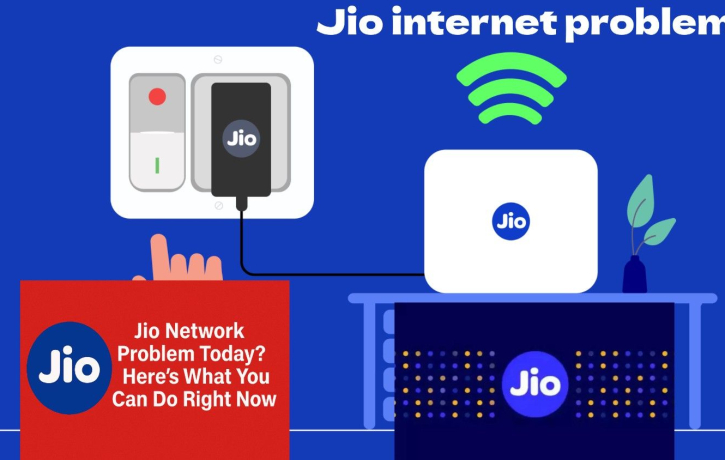- 1 ? Jio Network Problem: Understanding the Causes and Solutions
? Jio Network Problem: Understanding the Causes and Solutions
Reliance Jio, one of India’s largest and most popular telecom providers, has revolutionized mobile data usage with affordable plans, widespread 4G access, and a vast user base. However, like any major network, it is not immune to connectivity issues and service disruptions. Millions of users occasionally report Jio network problems, ranging from slow internet to complete signal outages — especially during peak hours or in densely populated areas.
This article explores the common reasons behind Jio network issues, possible user-side fixes, and when it’s time to seek official help.
? Common Jio Network Problems Users Face
Despite Jio’s strong infrastructure and widespread coverage, users across urban and rural regions often experience the following problems:
1. ? Weak or No Signal
-
A sudden drop in mobile signal strength.
-
“No Service” or “Emergency Calls Only” messages.
-
Difficulty in making or receiving calls.
2. ? Slow Internet Speed
-
Drastic reduction in 4G internet speed.
-
Websites not loading or streaming buffering endlessly.
-
Upload speeds are extremely low.
3. ? Call Drops and Voice Breaks
-
Frequent call disconnections.
-
Distorted or robotic voice quality.
-
One-way audio (you can hear, but can’t be heard, or vice versa).
4. ? Network Congestion
-
Call failures and slow data during evenings or weekends.
-
High-traffic areas like events, shopping malls, or festivals cause temporary disruptions.
5. ? No Data Connection Despite Network
-
Full bars are shown, but the internet is not working.
-
Mobile shows 4G, but apps like WhatsApp, Instagram, or YouTube won’t load.
?️ Causes of Jio Network Problems
There isn’t a single cause behind Jio’s network issues. Here are some major reasons:
1. Network Congestion
With over 400 million users, Jio’s network can get overcrowded, especially during peak hours. When too many people are using the same tower, speeds drop and connectivity suffers.
2. Geographical Limitations
In remote or rural areas, Jio’s infrastructure may be limited, causing weak signals. Hilly terrains, forests, or interiors with fewer towers may face reduced connectivity.
3. Weather Conditions
Heavy rain, storms, or extreme heat can impact signal transmission. Temporary tower outages due to weather are also a possibility.
4. Device Compatibility
Not all smartphones are optimized for Jio’s LTE bands. Older or non-VoLTE devices may struggle to maintain stable connections.
5. SIM Card or Software Issues
A faulty SIM, outdated software, or incorrect network settings can cause disruptions, even if the network itself is functioning well.
✅ How to Fix Jio Network Problems: Step-by-Step Guide
Before assuming a network-wide issue, try these user-side solutions:
? 1. Restart Your Phone
-
Simple but effective.
-
Clears temporary glitches and re-establishes a connection with the nearest tower.
? 2. Toggle Airplane Mode
-
Turn Airplane Mode ON for 10 seconds, then OFF.
-
Forces your device to reconnect to the network.
⚙️ 3. Check Network Settings
-
Go to Settings > Mobile Network > Network Mode, and select LTE/4G preferred.
-
Make sure VoLTE is enabled (if supported).
? 4. Update Software
-
Ensure your device’s firmware and carrier settings are up-to-date.
? 5. Reinsert the SIM Card
-
Power off your phone, remove and reinsert the SIM, and turn it on again.
-
Make sure the SIM is clean and seated properly.
? 6. Try Manual Network Selection
-
Go to Settings > Network Selection and try choosing Jio manually if automatic selection fails.
? 7. Use Wi-Fi Calling (If Available)
-
If your mobile signal is weak but you have Wi-Fi, enable Wi-Fi calling to make voice calls over the internet.
? When to Contact Jio Customer Care
If none of the above works and you’re still facing persistent issues, it’s time to reach out to Jio customer support.
Common reasons to contact them:
-
Network outage in your area.
-
SIM card damage or registration problems.
-
Account or recharge-related issues.
-
Need for a signal booster or tower request in weak zones.
You can reach Jio support via:
-
Customer care helpline (198 or 199)
-
Jio mobile app supports chat
-
Visiting the nearest Jio service center
?️ Jio’s Infrastructure and Tower Expansion Efforts
Reliance Jio has aggressively expanded its tower network, laid vast stretches of fiber optic cable, and launched 5G in metro cities. However, the sheer number of users and rapid data consumption often outpace these upgrades. The company continues to invest in:
-
Small cell towers for urban congestion relief
-
5G rollout in high-speed zones
-
Advanced signal repeaters in rural and hard-to-reach areas
Despite the occasional hiccups, Jio’s network coverage is among the widest in India, though not always the most stable in high-demand situations.
? User Tips to Minimize Jio Network Problems
-
Avoid heavy downloads during peak hours.
-
Keep your SIM in SIM Slot 1 for better 4G compatibility.
-
Don’t use outdated devices — ensure your smartphone supports Jio bands and VoLTE.
-
Inconsistent low-signal areas, consider requesting tower installation (if possible) through community petitions.
? Conclusion
Jio’s rise to telecom dominance brought affordable data to millions, but with popularity comes pressure. Jio network problems, though frustrating, are often manageable with basic troubleshooting. Understanding the causes — from congestion to configuration — helps users stay connected more reliably. And as Jio continues to enhance its infrastructure and roll out 5G, users can expect better, faster, and more stable services shortly.

